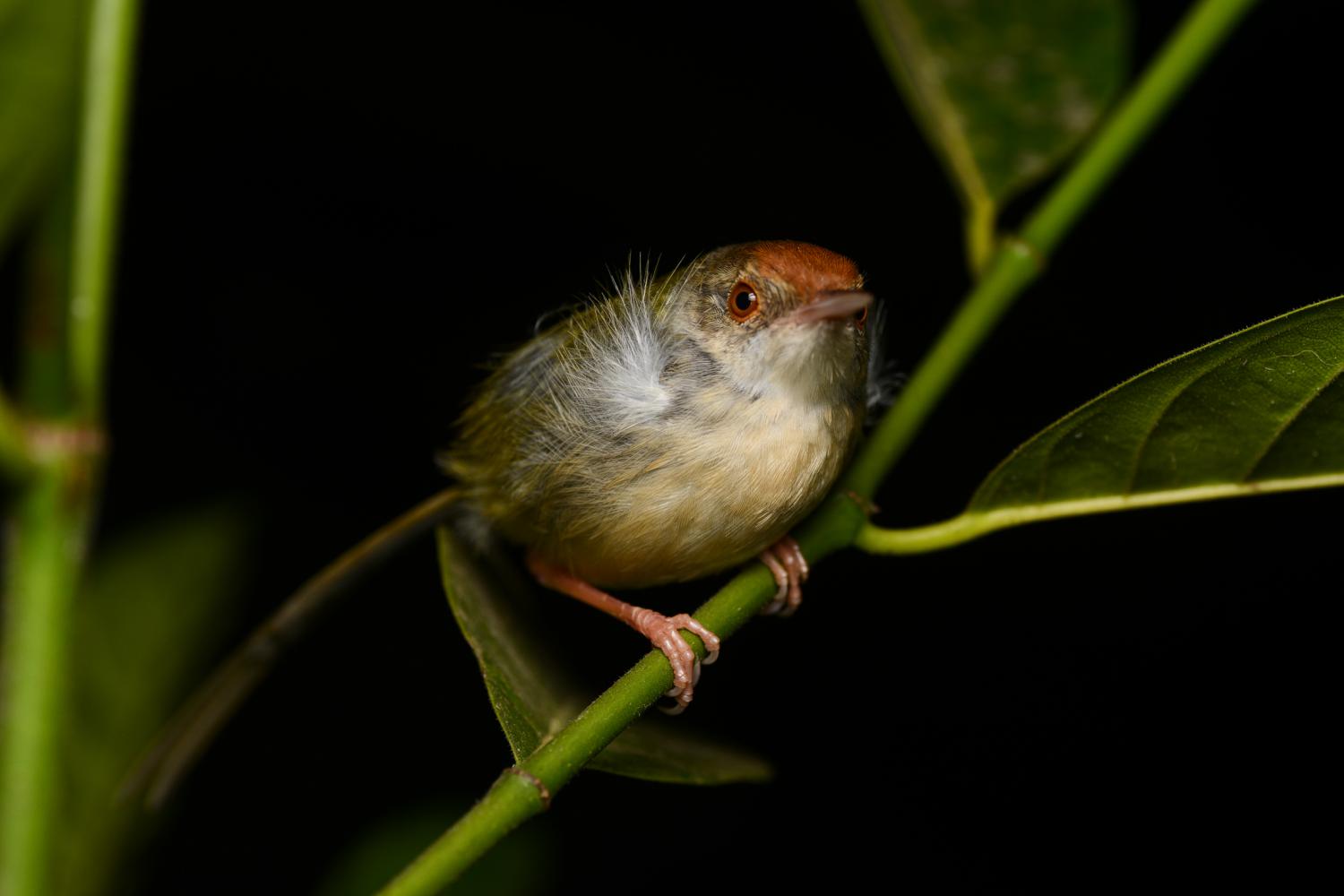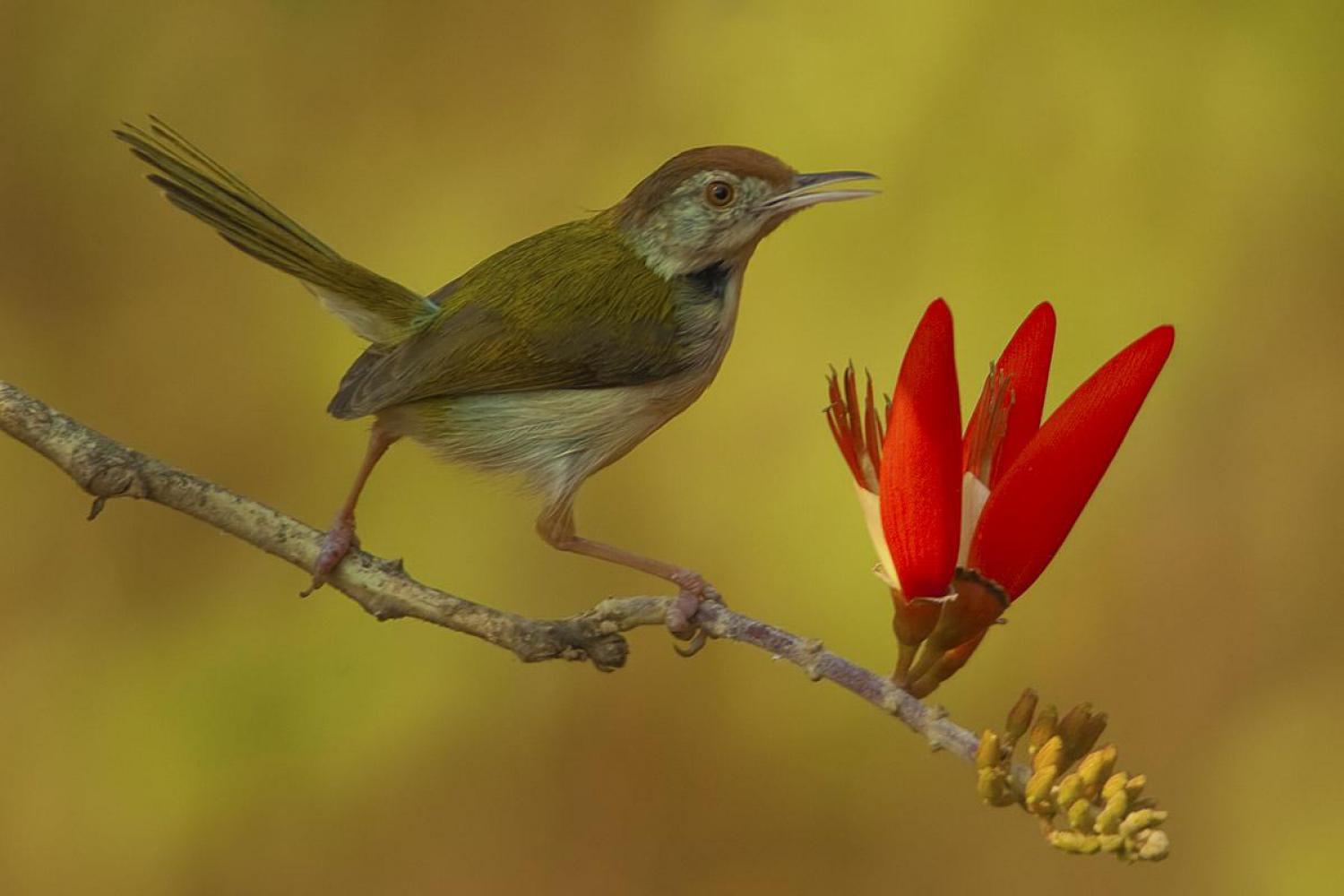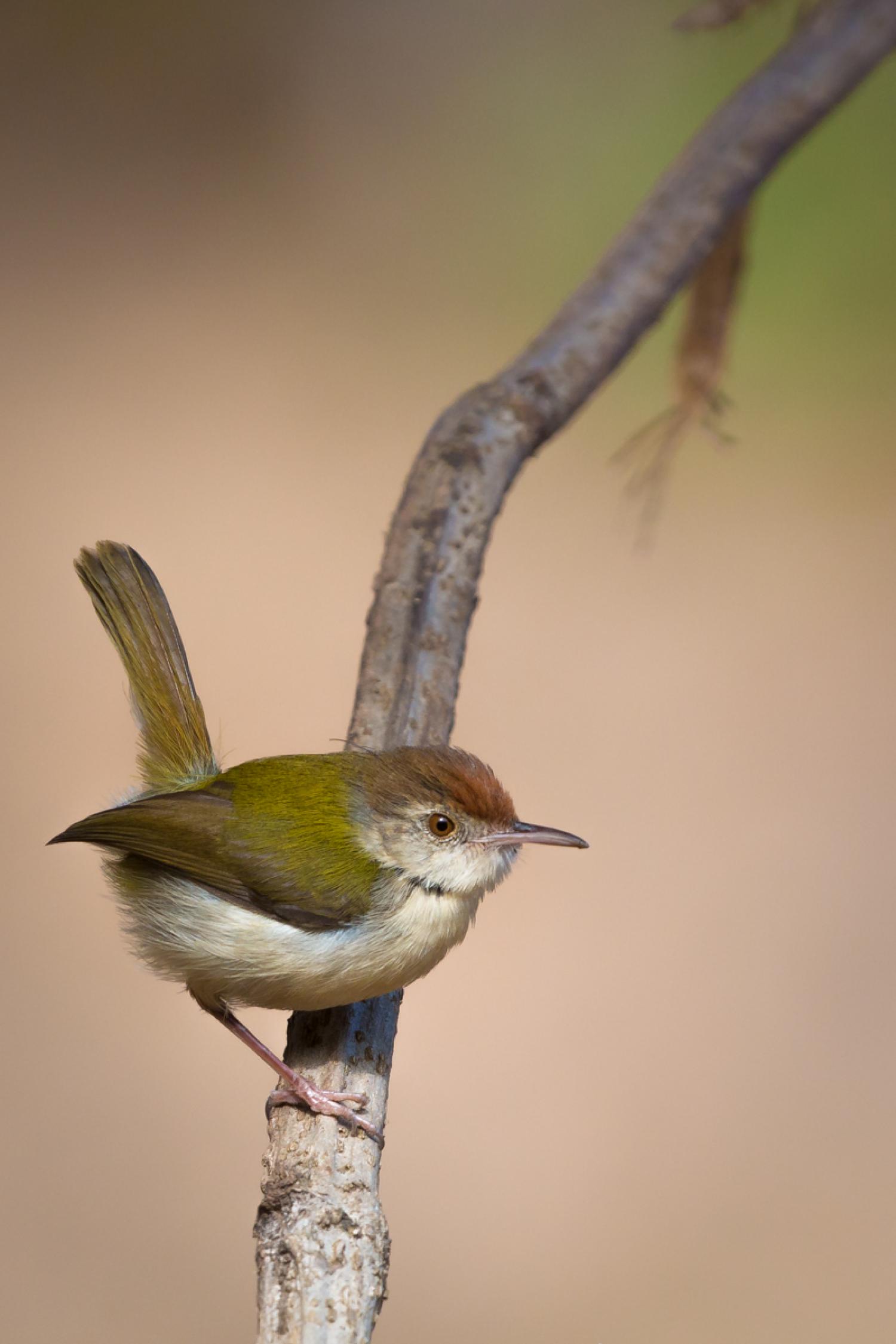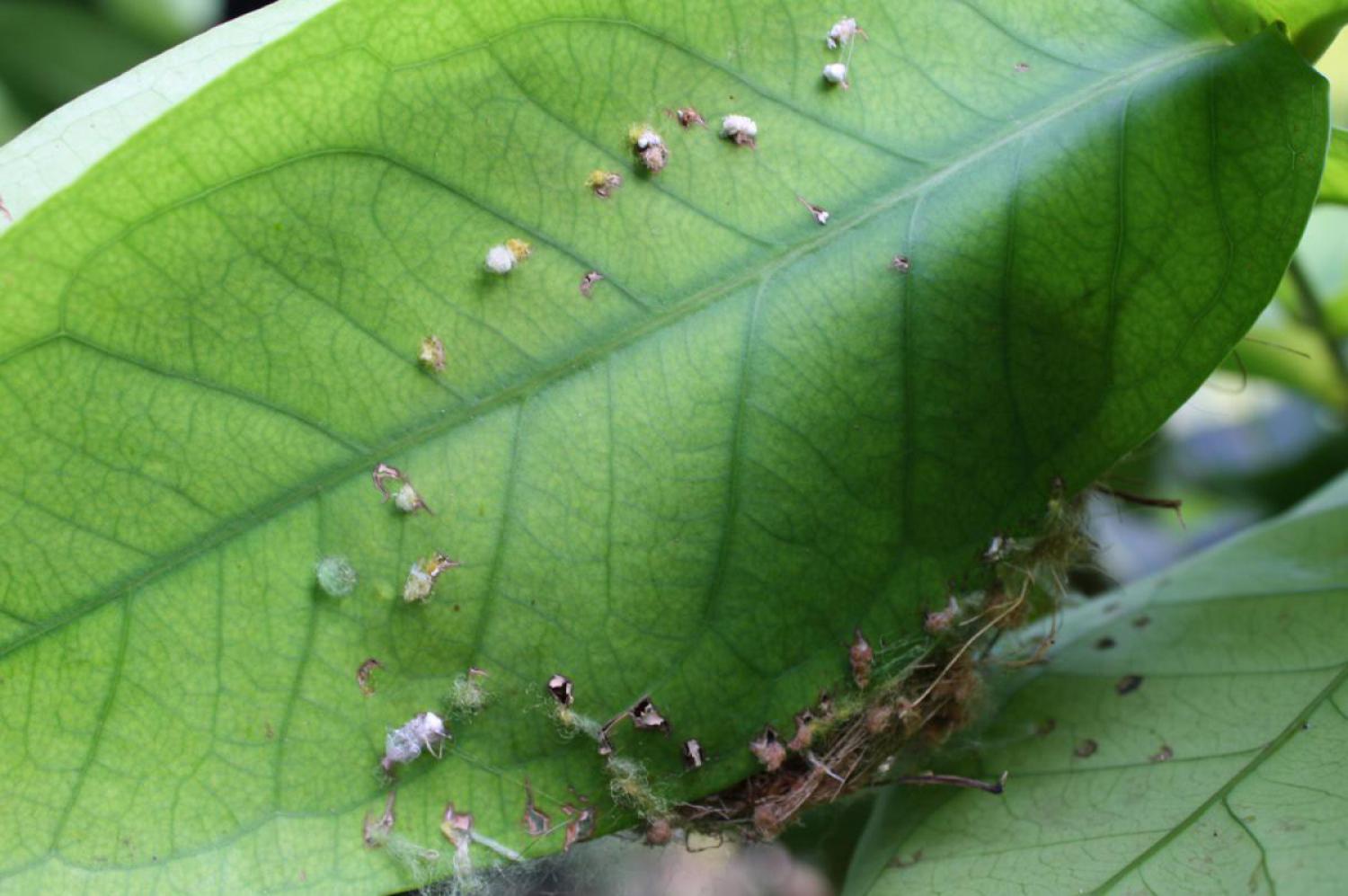Species of Thailand
Common tailorbird
Orthotomus sutorius
Thomas Pennant, 1769
In Thai: นกกระจิบธรรมดา
The common tailorbird (Orthotomus sutorius) is a songbird found across tropical Asia. Popular for its nest made of leaves "sewn" together and immortalized by Rudyard Kipling as Darzee in his Jungle Book, it is a common resident in urban gardens. Although shy birds that are usually hidden within vegetation, their loud calls are familiar and give away their presence. They are distinctive in having a long upright tail, greenish upper body plumage and rust coloured forehead and crown. This passerine bird is typically found in open farmland, scrub, forest edges and gardens. Tailorbirds get their name from the way their nest is constructed. The edges of a large leaf are pierced and sewn together with plant fibre or spider silk to make a cradle in which the actual nest is built.
Taxonomy and systematics
The scientific name sutorius means "cobbler" rather than "tailor" while Orthotomus means "straight-cutting".
The species was earlier placed in the family Sylviidae but more recent molecular studies place the species within the family Cisticolidae, along with Prinia and Cisticola.
A number of subspecies are recognized within its widespread range in South Asia and Southeast Asia. The nominate race is from the lowlands of Sri Lanka. Race O. s. fernandonis is found in the highlands of Sri Lanka. Neighbouring India has O.s. guzuratus in the peninsula and west to Pakistan while towards the north O. s. patia is found in the Terai of Nepal along the Himalayan foothills until Myanmar. A small population of O. s. patia is also found in the northern Eastern Ghats (Wangasara). The hills of northeastern India have O. s. luteus. In Southeast Asia O. s. inexpectatus and O. s. maculicollis are found in Thailand, Laos and Vietnam, Malaysia, Cambodia and Vietnam. South east China, including the island of Hainan, and Tonkin in Vietnam have O. s. longicauda while O. s. edela is found on Java.
Description
The common tailorbird is a brightly coloured bird, with bright green upperparts and creamy underparts. They range in size from 10 to 14 cm and weigh 6 to 10 g. They have short rounded wings, a long tail, strong legs and a sharp bill with curved tip to the upper mandible. They are wren-like with a long upright tail that is often moved around. The crown is rufous and the upperparts are predominantly olive green. The underside is creamy white. The sexes are identical, except that the male has long central tail feathers in the breeding season, although the reliability of sexing data accompanying museum specimens used in determining this sexual dimorphism has been questioned. Young birds are duller. When calling, the dark patches on the sides of the neck become visible. These are due to the dark pigmented and bare skin that are present in both sexes and sometimes give the appearance of a dark gorget.
Behaviour and ecology
Like most warblers, the common tailorbird is insectivorous. The song is a loud with variations across the populations. The disyllabic calls are repeated often. Tailorbirds are found singly or in pairs, usually low in the undergrowth or trees, sometimes hopping on the ground. They forage for insects and have been known to feed on a range of beetles and bugs. They are attracted to insects at flowers and are known to favour the inflorescences of mango. They also visit flowers such as those of Bombax, Salmalia for nectar and are sometimes covered in pollen, giving them a golden-headed appearance.
The birds roost alone during the non-breeding season but may roost side-by-side during the breeding season, sometimes with the newly fledged juvenile sandwiched between the adults. The roost sites chosen are thin twigs on trees with cover above them and were often close to human habitation and lights.
Breeding
The breeding season is March to December peaking from June to August in India, coinciding with the wet season. In Sri Lanka the main breeding periods are March to May and August to September, although they can breed throughout the year.
Although the name is derived from their nest construction habit, the nest is not unique and is also found in many Prinia warblers. The nest is a deep cup, lined with soft materials and placed in thick foliage and the leaves holding the nest have the upper surfaces outwards making it difficult to spot. The punctures made on the edge of the leaves are minute and do not cause browning of the leaves, further aiding camouflage. The nest lining of a nest in Sri Lanka that was studied by Casey Wood was found to be lined with lint from Euphorbia, Ceiba pentandra and Bombax malabaricum species. Jerdon wrote that the bird made knots, however no knots are used. Wood classified the processes used by the tailorbird in nest as sewing, rivetting, lacing and matting. In some cases the nest is made from a single large leaf, the margins of which are rivetted together. Sometimes the fibres from one rivet are extended into an adjoining puncture and appearing more like sewing. The stitch is made by piercing two leaves and drawing fibre through them. The fibres fluff out on the outside and in effect they are more like rivets. There are many variations in the nest and some may altogether lack the cradle of leaves. One observer noted that the birds did not utilize cotton that was made available while another observer, Edward Hamilton Aitken, was able to induce them to use artificially supplied cotton. The usual clutch is three eggs.
The incubation period is about 12 days. Both male and female feed the young. Mortality of eggs and chicks is high due to predation by rodents, cats, crow-pheasants, lizards and other predators. The young birds fledge in about 14 days. The female alone incubates according to some sources, while others suggest that both sexes incubate; however, both parents take part in feeding and sanitation. The males are said to feed the incubating female. An unusual case of a pair of tailorbirds adopting chicks in an artificially translocated nest belonging to a different pair has been recorded. Nests are sometimes parasitized by the Plaintive Cuckoo (Cacomantis merulinus).
In culture
"Rikki-Tikki-Tavi", one of Rudyard Kipling's Jungle Book stories, includes a tailorbird couple, Darzee (which means "tailor" in Urdu) and his wife, as two of the key characters. Darzee's wife is said to have feigned injury, but this behaviour is unknown in this species. A classic book of children's folk tales in Bengali by Upendrakishore Ray is titled "Tuntunir Boi", after the local name for the species, tuntuni.
This article uses material from Wikipedia released under the Creative Commons Attribution-Share-Alike Licence 3.0. Eventual photos shown in this page may or may not be from Wikipedia, please see the license details for photos in photo by-lines.
Category / Seasonal Status
BCST Category: Recorded in an apparently wild state within the last 50 years
BCST Seasonal status: Resident or presumed resident
Scientific classification
- Kingdom
- Animalia
- Phylum
- Chordata
- Class
- Aves
- Order
- Passeriformes
- Family
- Cisticolidae
- Genus
- Orthotomus
- Species
- Orthotomus sutorius
Common names
- Thai: นกกระจิบธรรมดา
Conservation status

Least Concern (IUCN3.1)
Photos
Please help us review the bird photos if wrong ones are used. We can be reached via our contact us page.
Range Map
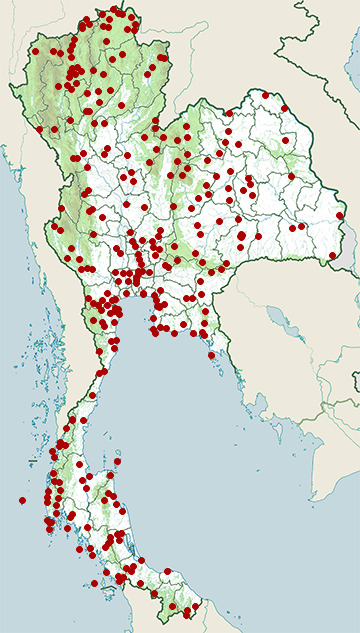
- Amphawa District, Samut Songkhram
- Ao Phang-Nga National Park
- Ban Bueng District, Chonburi
- Ban Chang District, Rayong
- Ban Laem District, Phetchaburi
- Ban Lat District, Phetchaburi
- Ban Phai District, Khon Kaen
- Ban Pho District, Chachoengsao
- Bang Lamung District, Chonburi
- Bang Lang National Park
- Bang Len District, Nakhon Pathom
- Bang Pa In District, Phra Nakhon Si Ayutthaya
- Bang Pahan District, Phra Nakhon Si Ayutthaya
- Bang Pakong District, Chachoengsao
- Bang Phra Non-Hunting Area
- Bang Pu Recreation Centre
- Bang Saphan Noi District, Prachuap Khiri Khan
- Bangkok Province
- Borabue District, Maha Sarakham
- Bueng Boraped Non-Hunting Area
- Chae Hom District, Lampang
- Chae Son National Park
- Chaiya District, Surat Thani
- Chaiyo District, Ang Thong
- Chaloem Phra Kiat District, Saraburi
- Chaloem Phrakiat Thai Prachan National Park
- Chat Trakan Waterfall National Park
- Chatturat District, Chaiyaphum
- Chiang Dao District, Chiang Mai
- Chiang Dao Wildlife Sanctuary
- Chiang Khong District, Chiang Rai
- Chiang Saen District, Chiang Rai
- Dan Sai District, Loei
- Doi Chong National Park
- Doi Inthanon National Park
- Doi Lang
- Doi Lo District, Chiang Mai
- Doi Pha Hom Pok National Park
- Doi Phu Kha National Park
- Doi Saket District, Chiang Mai
- Doi Suthep - Pui National Park
- Don Chedi District, Suphan Buri
- Dong Kheng Forest Park
- Erawan National Park
- Fang District, Chiang Mai
- Hala-Bala Wildlife Sanctuary
- Hang Chat District, Lampang
- Hat Chao Mai National Park
- Hat Wanakon National Park
- Hat Yai District, Songkhla
- Huai Chorakhe Mak Reservoir Non-Hunting Area
- Huai Kha Khaeng Wildlife Sanctuary
- Huai Nam Dang National Park
- Huai Talat Reservoir Non-Hunting Area
- Huai Yang Waterfall National Park
- In Buri District, Sing Buri
- Kaeng Khoi District, Saraburi
- Kaeng Khro District, Chaiyaphum
- Kaeng Krachan District, Phetchaburi
- Kaeng Krachan National Park
- Kaeng Som Maew Queen Sirikit Forest Park
- Kamphaeng Saen District, Nakhon Pathom
- Kanthararom District, Sisaket
- Kantharawichai District, Maha Sarakham
- Khanom District, Nakhon Si Thammarat
- Khao Ang Rue Nai Wildlife Sanctuary
- Khao Banthat Wildlife Sanctuary
- Khao Chong
- Khao Khiao - Khao Chomphu Wildlife Sanctuary
- Khao Khitchakut National Park
- Khao Kradong Forest Park
- Khao Laem National Park
- Khao Laem Ya - Mu Ko Samet National Park
- Khao Lak - Lam Ru National Park
- Khao Luang National Park
- Khao Nam Khang National Park
- Khao Nan National Park
- Khao Nang Phanthurat Forest Park
- Khao Phanom Bencha National Park
- Khao Phra - Bang Khram Wildlife Sanctuary
- Khao Phra Thaeo Wildlife Sanctuary
- Khao Pu - Khao Ya National Park
- Khao Sam Roi Yot National Park
- Khao Sanam Prieng Wildlife Sanctuary
- Khao Soi Dao Wildlife Sanctuary
- Khao Sok National Park
- Khao Yai National Park
- Khao Yoi District, Phetchaburi
- Khlong Hoi Khong District, Songkhla
- Khlong Luang District, Pathum Thani
- Khlong Phanom National Park
- Khon San District, Chaiyaphum
- Khuan Khanun District, Phatthalung
- Khun Nan National Park
- Khun Tan District, Chiang Rai
- Khung Kraben Non-Hunting Area
- Khura Buri District, Phang Nga
- Klaeng District, Rayong
- Ko Chang National Park
- Ko Lanta National Park
- Ko Libong
- Ko Phayam
- Ko Samui District, Surat Thani
- Kra Buri District, Ranong
- Kromluang Chumphon Wildlife Sanctuary
- Kui Buri National Park
- Kumphawapi District, Udon Thani
- Kut Thing Non-Hunting Area
- Laem Pak Bia
- Laem Son National Park
- Lam Nam Kok National Park
- Lan Sak District, Uthai Thani
- Lan Sang National Park
- Mae Ai District, Chiang Mai
- Mae Chan District, Chiang Rai
- Mae Fa Luang District, Chiang Rai
- Mae Mo District, Lampang
- Mae Moei National Park
- Mae Ping National Park
- Mae Rim District, Chiang Mai
- Mae Sai District, Chiang Rai
- Mae Taeng District, Chiang Mai
- Mae Tha, Lampang District, Lampang
- Mae Wong National Park
- Mu Ko Phetra National Park
- Mu Ko Ranong National Park
- Mueang Buriram District, Buriram
- Mueang Chaiyaphum District, Chaiyaphum
- Mueang Chanthaburi District, Chanthaburi
- Mueang Chiang Mai District, Chiang Mai
- Mueang Chiang Rai District, Chiang Rai
- Mueang Chonburi District, Chonburi
- Mueang Chumphon District, Chumphon
- Mueang Kanchanaburi District, Kanchanaburi
- Mueang Khon Kaen District, Khon Kaen
- Mueang Krabi District, Krabi
- Mueang Lampang District, Lampang
- Mueang Lamphun District, Lamphun
- Mueang Loei District, Loei
- Mueang Lopburi District, Lopburi
- Mueang Maha Sarakham District, Maha Sarakham
- Mueang Nakhon Nayok District, Nakhon Nayok
- Mueang Nakhon Pathom District, Nakhon Pathom
- Mueang Nakhon Ratchasima District, Nakhon Ratchasima
- Mueang Nakhon Si Thammarat District, Nakhon Si Thammarat
- Mueang Nan District, Nan
- Mueang Nong Khai District, Nong Khai
- Mueang Nonthaburi District, Nonthaburi
- Mueang Pathum Thani District, Pathum Thani
- Mueang Pattani District, Pattani
- Mueang Phang Nga District, Phang Nga
- Mueang Phatthalung District, Phatthalung
- Mueang Phayao District, Phayao
- Mueang Phetchaburi District, Phetchaburi
- Mueang Phichit District, Phichit
- Mueang Phitsanulok District, Phitsanulok
- Mueang Phuket District, Phuket
- Mueang Ranong District, Ranong
- Mueang Ratchaburi District, Ratchaburi
- Mueang Rayong District, Rayong
- Mueang Sa Kaeo District, Sa Kaeo
- Mueang Samut Sakhon District, Samut Sakhon
- Mueang Samut Songkhram District, Samut Songkhram
- Mueang Satun District, Satun
- Mueang Sisaket District, Sisaket
- Mueang Songkhla District, Songkhla
- Mueang Sukhothai District, Sukhothai
- Mueang Suphanburi District, Suphan Buri
- Mueang Surat Thani District, Surat Thani
- Mueang Surin District, Surin
- Mueang Tak District, Tak
- Mueang Udon Thani District, Udon Thani
- Nam Nao National Park
- Nam Phong National Park
- Namtok Mae Surin National Park
- Namtok Phlio National Park
- Namtok Sam Lan National Park
- Ngao Waterfall National Park
- Non Din Daeng District, Buriram
- Non Sang District, Nong Bua Lamphu
- Non Thai District, Nakhon Ratchasima
- Nong Bong Khai Non-Hunting Area
- Nong Han Lake
- Nong Plak Phra Ya – Khao Raya Bangsa Non-Hunting
- Nong Song Hong District, Khon Kaen
- Nong Thung Thong Non-Hunting Area
- Nong Waeng Non-Hunting Area
- Nong Ya Plong District, Phetchaburi
- Omkoi Wildlife Sanctuary
- Op Khan National Park
- Pa Sak Chonlasit Dam Non-Hunting Area
- Pa Sang District, Lamphun
- Pachee River Wildlife Sanctuary
- Pai District, Mae Hong Son
- Pak Chong District, Nakhon Ratchasima
- Pak Kret District, Nonthaburi
- Pak Phanang District, Nakhon Si Thammarat
- Pak Phli District, Nakhon Nayok
- Pak Thale
- Pak Tho District, Ratchaburi
- Pang Sida National Park
- Pang Sila Thong District, Kamphaeng Phet
- Pha Daeng National Park
- Pha Hin Ngam National Park
- Pha Nam Yoi Forest Park
- Pha Taem National Park
- Phaisali District, Nakhon Sawan
- Phan District, Chiang Rai
- Phatthana Nikhom District, Lopburi
- Phi Phi Islands
- Phimai District, Nakhon Ratchasima
- Pho Prathap Chang District, Phichit
- Phra Nakhon Si Ayutthaya District, Phra Nakhon Si Ayutthaya
- Phu Chi Fa Forest Park
- Phu Chong Na Yoi National Park
- Phu Foi Lom National Park
- Phu Hin Rong Kla National Park
- Phu Khiao Wildlife Sanctuary
- Phu Kradueng National Park
- Phu Langka National Park
- Phu Luang Wildlife Sanctuary
- Phu Soi Dao National Park
- Phu Suan Sai National Park
- Phu Toei National Park
- Phu Wiang National Park
- Phunphin District, Surat Thani
- Phutthamonthon District, Nakhon Pathom
- Pran Buri District, Prachuap Khiri Khan
- Pran Buri Forest Park
- Ramkhamhaeng National Park
- Sai Noi District, Nonthaburi
- Sai Yok District, Kanchanaburi
- Sai Yok National Park
- Sakaerat Environmental Research Station
- Salak Pra Wildlife Sanctuary
- Samae San Island
- Samut Prakan Province
- San Kala Khiri National Park
- San Sai District, Chiang Mai
- Sanam Bin Reservoir Non-Hunting Area
- Sangkhla Buri District, Kanchanaburi
- Sattahip District, Chonburi
- Si Racha District, Chonburi
- Si Satchanalai District, Sukhothai
- Si Satchanalai National Park
- Similan Islands
- Sirinat National Park
- Sop Prap District, Lampang
- Sri Nakarin Dam National Park
- Sri Phang Nga National Park
- Su-ngai Kolok District, Narathiwat
- Sukhirin District, Narathiwat
- Sung Men District, Phrae
- Ta Phraya National Park
- Taksin Maharat National Park
- Takua Pa District, Phang Nga
- Taphan Hin District, Phichit
- Tarutao National Marine Park
- Tat Mok National Park
- Tha Chang District, Sing Buri
- Tha Sala District, Nakhon Si Thammarat
- Tha Takiap District, Chachoengsao
- Tha Yang District, Phetchaburi
- Thai Mueang District, Phang Nga
- Thalang District, Phuket
- Thale Ban National Park
- Thale Noi Non-Hunting Area
- Tham Pratun Non-Hunting Area
- Tham Sakoen National Park
- Thanyaburi District, Pathum Thani
- Thap Lan National Park
- Thung Salaeng Luang National Park
- Thung Yai Naresuan Wildlife Sanctuary
- Ton Nga-Chang Wildlife Sanctuary
- Ton Pariwat Wildlife Sanctuary
- Wang Mai Forest Restoration Project
- Wang Nam Yen District, Sa Kaeo
- Wang Saphung District, Loei
- Wapi Pathum District, Maha Sarakham
- Wat Phai Lom & Wat Ampu Wararam Non-Hunting Area
- Wat Tham Erawan Non-Hunting Area
- Wiang Kaen District, Chiang Rai
- Wiang Lo Wildlife Sanctuary
- Yan Ta Khao District, Trang
